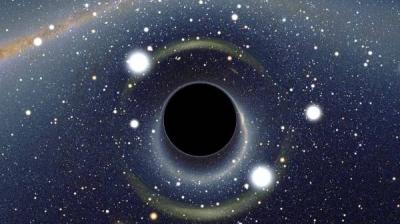In a groundbreaking discovery, an international team of astronomers has observed the oldest black hole, dating back to a time when the universe was barely 400 million years old. Astrophysicist Jan Scholtz at the Kavli Institute for Cosmology at the University of Cambridge revealed that this discovery pushes the date of the oldest massive black hole "back by about 200 million years," according to a study published yesterday, Wednesday.
The co-author of the study published in the journal "Nature" noted that this research "will fuel a new generation of theoretical models" to explain the existence of similar phenomena in the young universe, over 13 billion years ago. The mass of this black hole is estimated to be 1.6 million times that of our Sun. Like all black holes, it is invisible and absorbs surrounding matter by emitting a tremendous amount of light in its vicinity. It is this light that enabled the discovery of the galaxy in which the black hole resides, named "GN-z11", which was announced in 2016 using the Hubble Space Telescope.
At that time, GN-z11 was the oldest galaxy observed by Hubble and, subsequently, the farthest until the James Webb Space Telescope began operations in 2022, leading to the discovery of the black hole within GN-z11. This discovery adds to other findings made possible by the James Webb Space Telescope, revealing a young universe containing brighter objects than previously anticipated.
The black hole discovered by the international team led by Cambridge University dates back to 430 million years after the Big Bang, a time known as the cosmic dawn, during the birth of the first stars and galaxies at the end of the so-called "dark ages." The challenge posed by a black hole of this size lies in understanding how it could grow so rapidly. It typically takes hundreds of millions or billions of years for such growth, as seen in later-discovered black holes.
Astrophysicist Stéphane Charlot from the Paris Institute of Astrophysics, a co-author of the study, explained to AFP that its characteristics "indicate a faster and earlier growth than other known ancient black holes." Therefore, "the mechanisms for the formation of black holes in the young universe may differ from those we know in our closer universe," according to Charlot.
If we adhere to classical scenarios, "the universe is too small to host such a massive black hole, so we need to think of other ways for it to appear," says Roberto Maiolino, an astrophysicist at the University of Cambridge and the lead author of the study, in statements provided in a press release.
Theorists propose that such a body could have been born "large," from the explosion of a massive star at the end of its life or from the rapid concentration of a dense gas cloud, without going through a star formation phase. Once born, the GN-z11 black hole might have consumed the surrounding gas to grow rapidly. This is easier because "observations seem to indicate a high density of this gas," according to Charlot.
The study published in Nature does not rule out any of these scenarios, according to Jan Scholtz, who counts on the extraordinary observational capabilities of the James Webb Telescope to shed light on this phenomenon. The astrophysicist states, "We can expect to discover other objects when we have a larger number of in-depth observations of larger parts of the sky."




